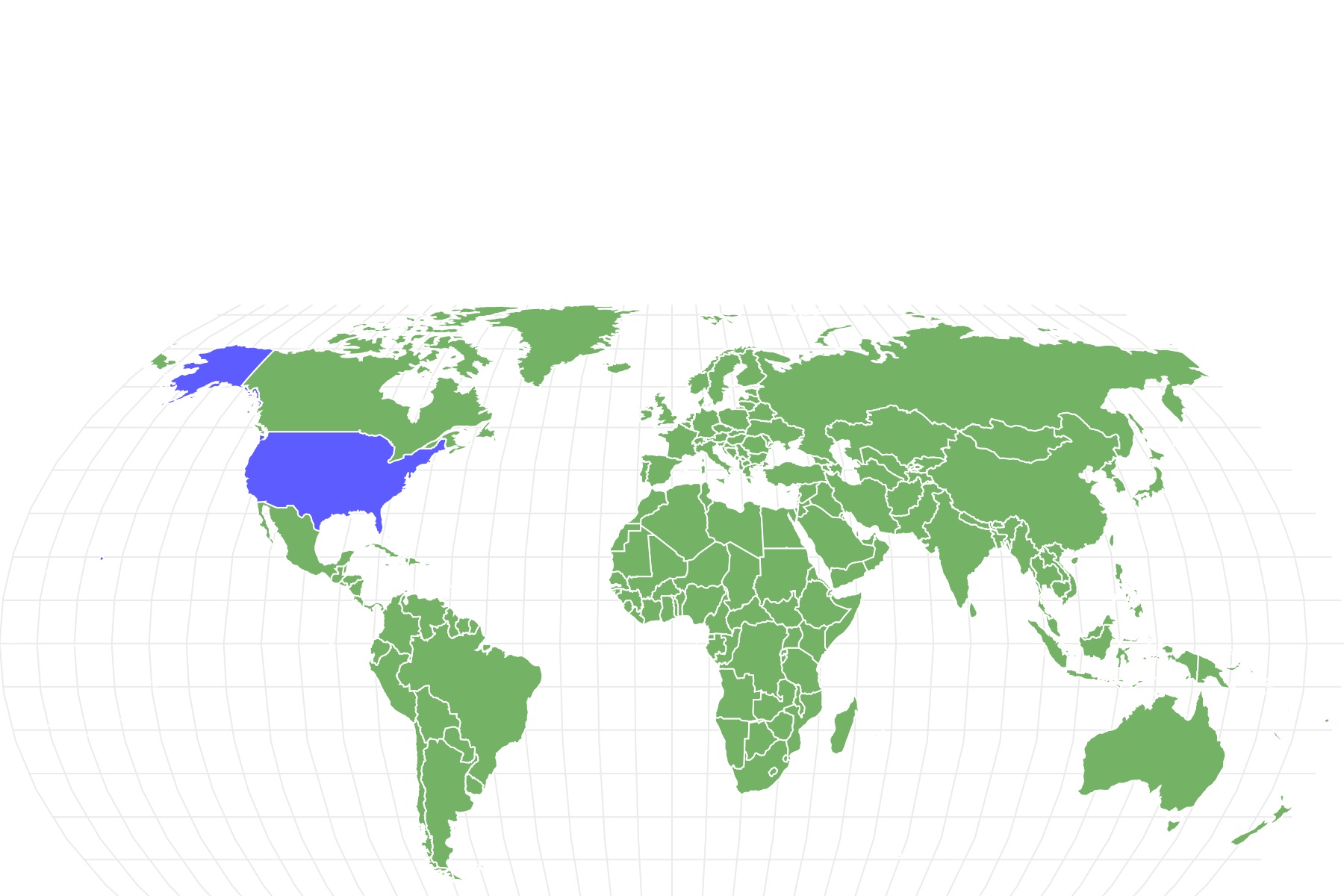Shepweiler
Canis lupus
The Shepweiler is an excellent guard dog.
Advertisement
Shepweiler Scientific Classification
- Kingdom
- Animalia
- Phylum
- Chordata
- Class
- Mammalia
- Order
- Carnivora
- Family
- Canidae
- Genus
- Canis
- Scientific Name
- Canis lupus
Read our Complete Guide to Classification of Animals.
Shepweiler Conservation Status
Shepweiler Facts
- Diet
- Omnivore
Shepweiler as a Pet:
- General Health
- Energy Level
- Shedability
- Trainability
- Intelligence
- Tendency to Chew
- Size
- Family and kid friendliness
- Yappiness / Barking
- High
- Separation Anxiety
- Moderate
- Preferred Temperature
- Average climate
- Exercise Needs
- High
- Friendly With Other Dogs
- Moderate
- Pure bred cost to own
- $200 to $1,500
- Dog group
- Non-sporting
- Male weight
- 75-115 lbs
- Female weight
- 70-110 lbs
This post may contain affiliate links to our partners like Chewy, Amazon, and others. Purchasing through these helps us further the A-Z Animals mission to educate about the world's species.
View all of the Shepweiler images!
The Shepweiler is a good choice for experienced and diligent owners who have the time and knowledge to train it and care for its needs.
If you’re looking for a loyal and protective working or guard dog, then the Shepweiler could be the dog for you. This relatively uncommon hybrid is produced by crossing the Rottweiler and the German Shepherd. Most Shepweilers will have a big, muscular body, long legs, a large muzzle, powerful jaws, blue and/or brown eyes, and droopy ears that sometimes become erect when the dog is particularly attentive. The straight thick coat of fur is usually some combination of black, brown, white, and tan. Red, fawn, and sable are common colors as well.
See all of our expert product reviews.

3 Pros and Cons of Owning a Shepweiler
| Pros! | Cons! |
|---|---|
| Loyal and Protective The Shepweiler is an excellent guard dog that will watch over members of the family. | Wary of Strangers The natural suspicion of strangers makes it an excellent watchdog, but it also does not make friends easily. |
| Intelligent and Hard-Working This dog can be taught to perform a wide variety of different tasks. | Heavy Shedder The Shepweiler’s coat leaves quite a mess to clean; it’s also not a good choice for people with allergies. |
| Active This mix is a good choice for highly active owners. | High Maintenance This dog requires plenty of socialization, physical activity, and mental stimulation. |

Shepweilers are intelligent, loyal, and protective.
©Dreamland Photography/Shutterstock.com
Evolution and Origins
As the Shepweiler is a hybrid, its origins are not known but it’s thought that this breed was developed in the late 1990s when “designer dogs” of various crossbreeds began to be popular. The Shepweiler is usually a first-generation hybrid, but some multi-generation crosses do exist as well, and it will inherit many of its parents’ traits, though not in a perfect 50/50 split. Both of the Shepweiler’s parent breeds have their roots in Germany.
The German Shepherd, a muscular and agile herding dog, was first used to wrangle sheep. In the 1890s, German cavalry officer and dog breeder Captain Max Emil Friedrich von Stephanitz began developing the breed that became the modern-day dog. In the U.K., German Shepherds used to be referred to as “Alsatians” as many of these dogs were present in the Alsace region of France that was once part of Germany and to avoid association with Germany following World War II. Due to their intelligence and ability to learn tasks quickly, German Shepherds make excellent watchdogs, police dogs, search and rescue dogs, and overall service dogs.
The Rottweiler was also developed in Germany, in Rottweil, a region where a Roman army was present in the 2nd century. It is believed to be one of the oldest dog breeds and its ancestors are the drover dog from ancient Roman times and the Italian Mastiff. It was initially used for herding cattle, hunting, or pulling smaller-sized carts. During the Middle Ages and the Renaissance, these dogs assisted butchers by carrying their money to market. Over the centuries, this strong and muscular working breed has been used to herd livestock, guard homes, and do police, rescue, and service work.
Health and Entertainment for your Shepweiler
- The Best Wet Food for Senior Dogs
- The Best Dog Food for Labrador Retrievers (Senior, Puppy, and Adult)
- These Are the Best Probiotics for Dogs (They Actually Work)
- Victor Senior Healthy Weight Dog Food Review: Recalls, Pros, Cons, and More
- The Best Dog Food for Small Dogs (Puppy, Adult, Senior): Ranked and Reviewed
See all of our expert product reviews.
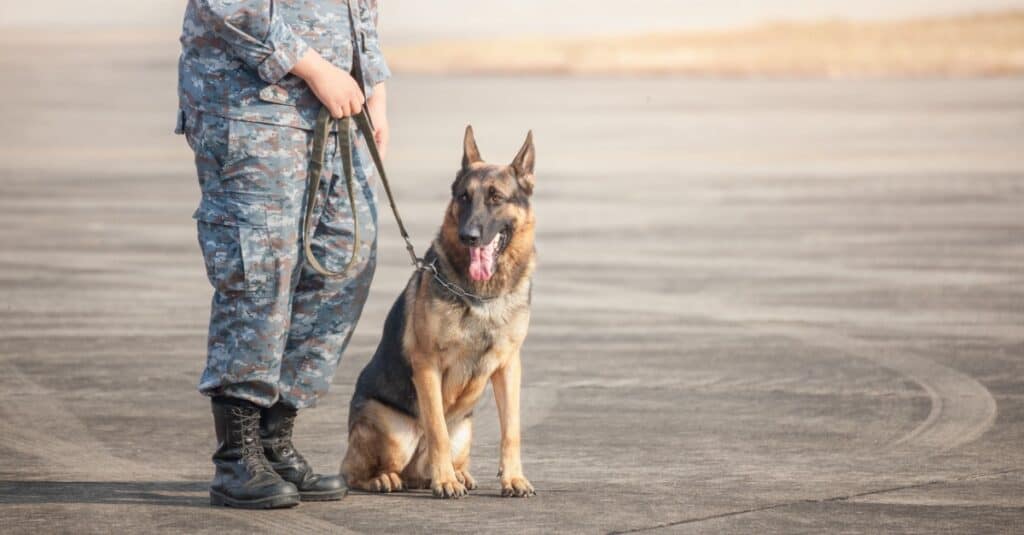
A parent breed of the Shepweiler, the German Shepherd is used in police and military operations.
©iStock.com/Puttachat Kumkrong
Size and Weight
The Shepweiler is a big dog with a strong and muscular frame. Females are slightly smaller than males on average.
| Height (Male) | 24 to 27 inches |
| Height (Female) | 22 to 25 inches |
| Weight (Male) | 75 to 115 pounds |
| Weight (Female) | 70 to 110 pounds |
Common Health Issues
The Shepweiler is a fairly healthy dog with a lifespan of around 10 to 13 years. But just like its two parent breeds, this hybrid may be prone to cataracts, cancer, bloating, autoimmune disorders, hip and elbow problems, skin irritation, hypothyroidism, and a congenital heart defect.
In order to reduce the chances of your dog developing these health problems, it is always important to buy your Shepweiler from high-quality breeders who will screen for common conditions that are known to afflict this type of dog. If necessary, ask the breeders for proof of their dogs’ health. Once you’ve purchased a dog, it is also necessary to have regular checkups at the vet to catch early health problems. In summation, these are the most common health issues of a Shepweiler:
- Allergies
- Cataracts
- Bloating
- Joint Problems
- Cancer.

It’s important to source your Shepweiler from a trusted breeder who will screen for common health issues.
©pohanka.photo/Shutterstock.com
Temperament
The Shepweiler’s parent breeds both have an unfortunate reputation for exhibiting some aggressive behavior, but this is only the case when the dog is mistreated or not properly trained by a bad owner. If the Shepweiler has been properly socialized and undertaken obedience training, then it should grow into a well-behaved and friendly adult.
They can be a hard-working, diligent, loving, and self-confident member of the family. Their naturally protective personality makes them excellent guard dogs, and they also have the capabilities to perform complex work. The Shepweiler does require plenty of physical and mental stimulation (and may turn annoying if it does not receive that), so they may offer only frustration for busy or negligent owners.
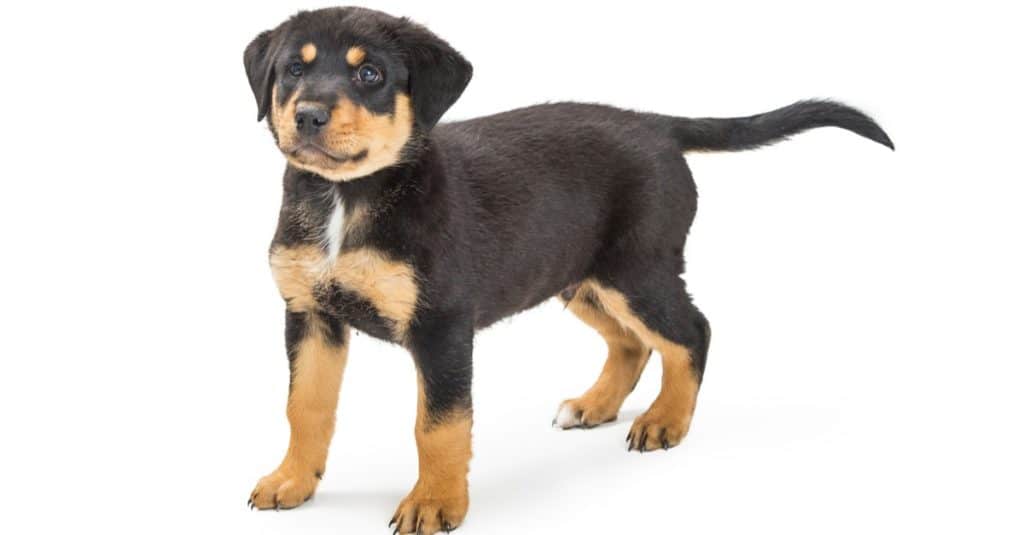
If a Shepweiler has been properly socialized it should become well-behaved and friendly as an adult.
©Susan Schmitz/Shutterstock.com
How to Take Care of the Shepweiler
The Shepweiler is a good choice for experienced and diligent owners who have the time and knowledge to train it and care for its considerable needs. First-time or novice owners may struggle with the dog’s tendency to push the boundaries during the training process. If you have any other questions or concerns about the proper way to care for this dog, then you should always consult with your vet.
The Best Dog Food for Shepweilers
A fully grown Shepweiler probably needs around 3 to 4 cups of high-protein dry food per day. The exact amount will depend on the dog’s age, size, and activity level. Since this dog may be particularly prone to bloating, it is a good idea to split this into three or four meals per day. Bloating is a very serious condition that can cause the stomach to expand beyond its normal size, which can cause pain and damage. Some dogs may also be allergic to wheat, soy, and corn as well. Aim for allergy-prevention dog foods with limited ingredients.
So A-Z Animals believes the best dog food for Shepweilers is Natural Balance Limited Ingredient Diet | Adult Grain-Free Canned Dog Food.
We like this dog food for Shepweilers because it eliminates the grain that can trigger the breed’s food sensitivities. Also, wet food can be a good kibble alternative for breeds like Shepweilers that can experience bloat, because dry food can expand in contact with water/moisture to exacerbate bloat. This dog food manages to cut out the sub-optimal ingredients in favor of high-quality proteins and plenty of calcium for the bones and joints.
Check Chewy and Amazon for this product.
- Made with unique venison as a protein source
- Abundant in the vitamins B6 and B12, which are essential for a healthy immune system, metabolism, and gastrointestinal function
- It lacks some digestive aids, such as omega fatty acids and prebiotics, which can soothe sensitive stomachs
- Sweet potatoes substitute the grains normally found in a regular dog's diet
Maintenance and Grooming
As a relatively heavy shedder, the Shepweiler needs to be groomed at least once a week to maintain the proper health of the coat. It is recommended to do at least some light brushing every day with a slicker brush or de-shedder to remove the loose hair as well. Because of its tendency to develop dry and irritated skin, bathing should take place only as needed with a light shampoo when the dog becomes dirty. Other important aspects of the dog’s hygiene include regular nail trimmings, ear cleanings, and teeth brushing.
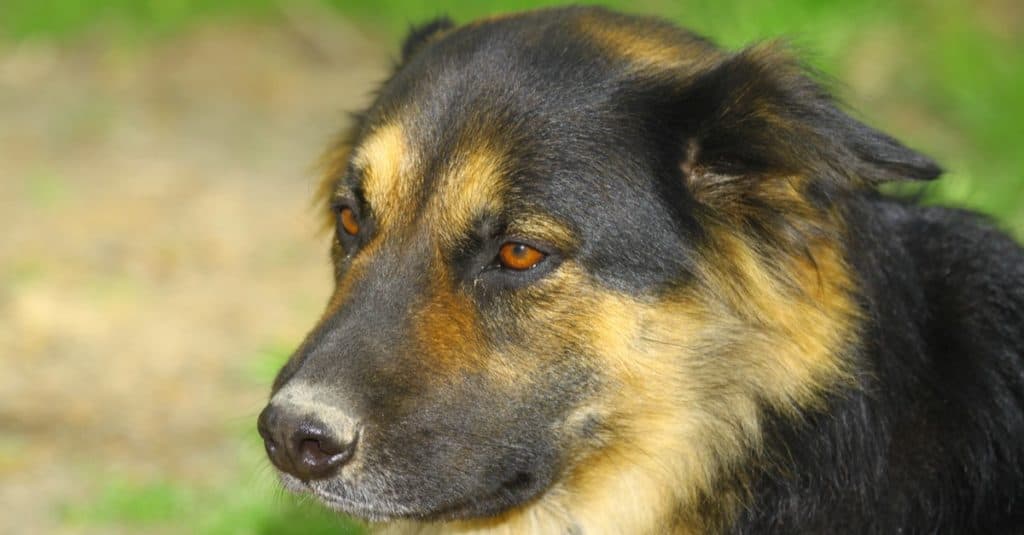
Shepweilers need to be groomed at least once per week as they are heavy shedders.
©Barry Blackburn/Shutterstock.com
Training
The Shepweiler is a very smart dog that will follow commands with great proficiency and aplomb. They will benefit enormously from a disciplined training regime. But many owners make the mistake of assuming that these dogs need to be treated with harshness and aggression. This is not the case. While the Shepweiler may have the tendency to push boundaries and test your limits, owners should respond with patience, understanding, and positive reinforcement methods.
You will need to establish the fact that you’re the leader, but don’t react harshly and negatively when it disobeys. Most importantly, you will need to be consistent with your commands. The dog cannot read your mind, and sending mixed signals may just confuse it. If you need help with training at all, then you may want to consult with a professional.
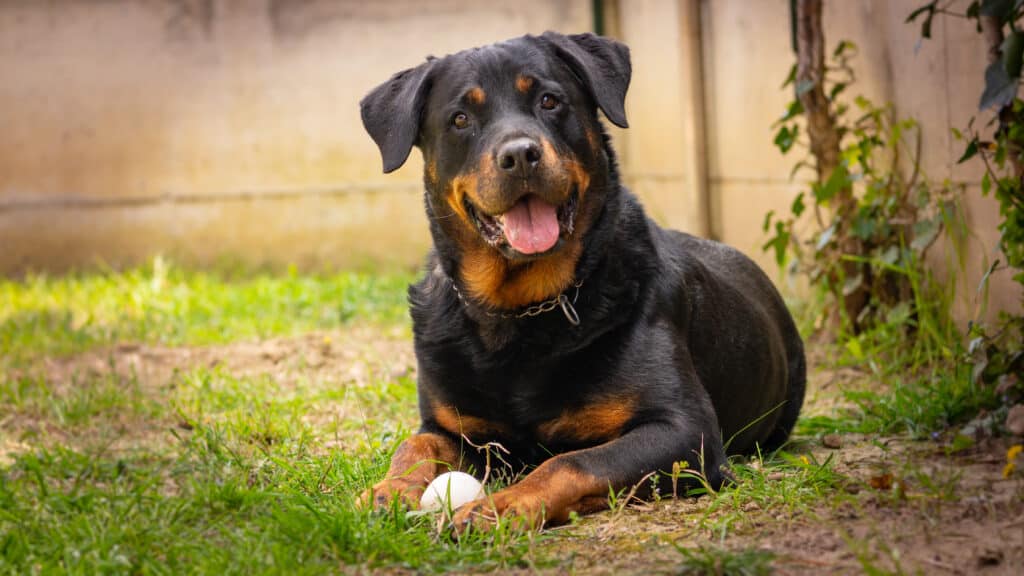
Like its parent breed the Rottweiler, the Shepweiler is smart and learns fast.
©nicolas.fontana/Shutterstock.com
Exercise
The Shepweiler needs between 60 to 90 minutes of exercise a day, divided into several smaller sessions. This dog should be satisfied with long walks, jogs, hikes, fetching, playtime, and some time to roam around in a park or yard. It may also excel at some complex tricks, tasks, and sports. If the dog’s daily exercise needs are neglected, then it might resort to destructive behavior such as chewing and barking.
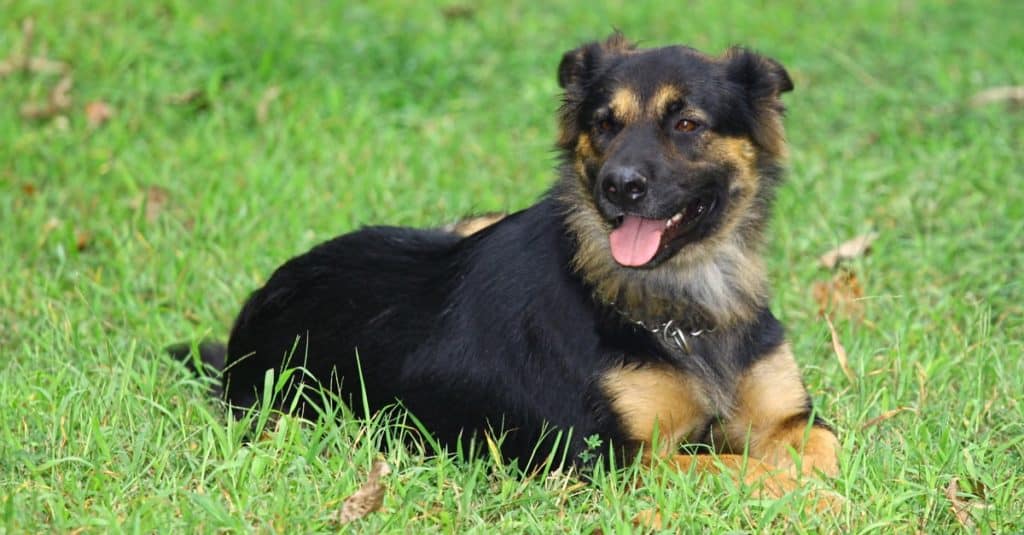
The Shepweiler needs 60-90 minutes of daily exercise, which can include roaming in a park or yard.
©Barry Blackburn/Shutterstock.com
Puppies
In order to become a well-behaved fully grown adult, the Shepweiler needs to begin proper socialization and obedience training within the first few months of its life. Part of this process will entail introducing your puppy to as many new people and situations as possible to counteract some of its natural wariness toward strangers. Shepweiler puppies shouldn’t be too difficult to house train, but a crate may nevertheless be useful if you are experiencing any difficulties. Owners will also need to pay close attention to the puppy’s physical development. Until the dog is fully mature, its joints may be sensitive and frail. Be careful about letting puppies jump around or play on hard surfaces.

Aim to introduce a Shepweiler puppy to new people and situations to counteract its natural wariness toward strangers.
©Karen Sanders Studio/Shutterstock.com
Shepweilers and Children
Despite its enormous size, the Shepweiler should do well with most children. It is loyal and protective but also sometimes very loving and playful. However, parents may need to be careful about letting this dog unsupervised around smaller children, since its size can be intimidating.

Like its parent breed the German Shepherd, the Shepweiler is loyal and protective.
©Stone36/Shutterstock.com
Dogs Similar to the Shepweiler
If the Shepweiler appeal to you, then you might want to check out the following breeds. They have similar physical characteristics, behaviors, and traits.
- Doberman Pinscher – This confident, fearless, and alert breed is one of the best watchdogs around. It sports a muscular physique, keen intelligence, and a short brown or red coat of fur.
- Bullmastiff – Among the largest of all dogs, the big, muscular Bullmastiff descends from a cross between the Bulldog and the Mastiff. This affectionate, courageous, and loyal dog was originally bred to protect the vast estates of English aristocrats from game poachers.
- Beauceron – Despite looking a bit like a Rottweiler, this kind gentle, obedient, and loyal breed is actually a French herding and guard dog with a big international following. Its enormous ability for hard work is one of its defining traits.
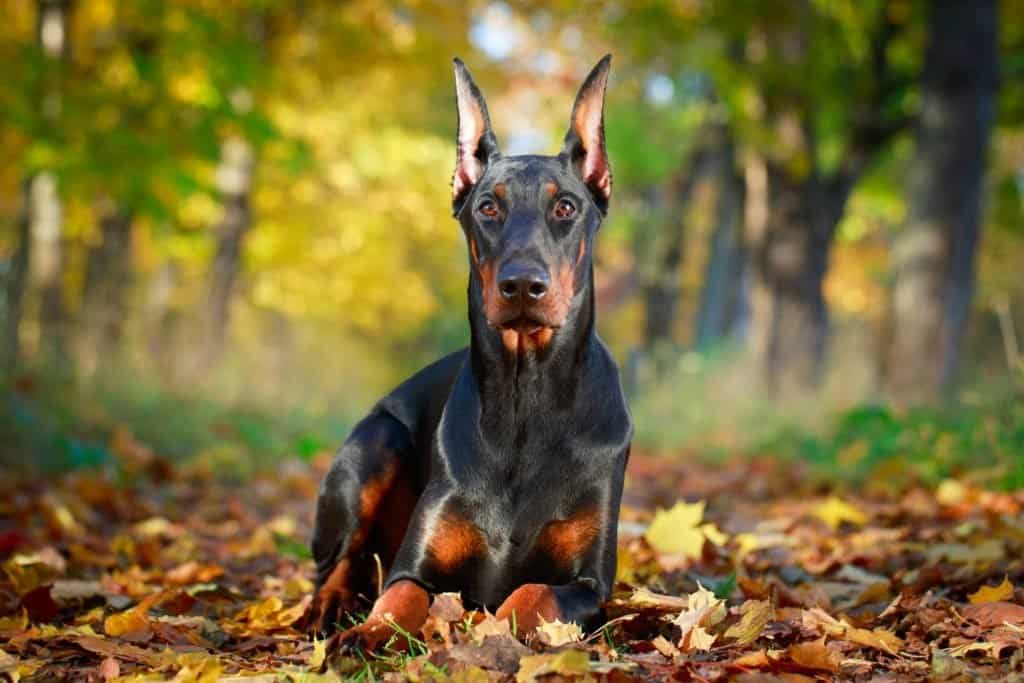
Like Shepweilers, Doberman Pinschers make great watchdogs.
©DragoNika/Shutterstock.com
Famous Shepweilers
As a relatively obscure and unknown crossbreed, the Shepweiler does not have a large following. But its two parent breeds, the Rottweiler and German Shepherd, regularly rank among the top 10 most popular dogs in the United States.
A dog named Horand von Grafrath born in 1895 became famous as it was the first German Shepherd bred by Captain Max Emil Friedrich von Stephanitz, which became the genetic basis for the modern-day breed.
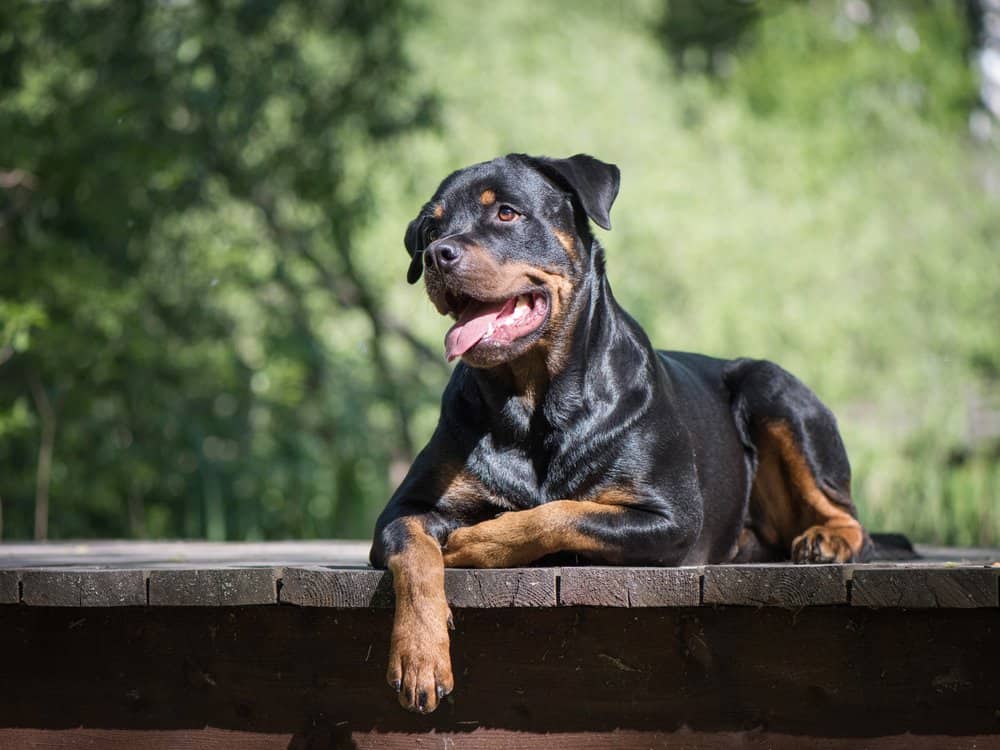
The Rottweiler is among the top 10 most popular dogs in the U.S.
©EKATERINA SOLODILOVA/Shutterstock.com
Popular Names for the Shepweiler
If you need help coming up with a good Shepweiler name, then you might want to consider the following options:
- Rocky
- Bella
- Max
- Charlie
- Zeus
- Charlie
- Luna
- Roxy
- Harley
- Moose
Shepweiler FAQs (Frequently Asked Questions)
What is a Shepweiler?
The Shepweiler is a cross between a Rottweiler and a German Shepherd. The crossbreed’s most appealing qualities are its loyalty, intelligence, and hard-working nature. Physically, this hybrid will combine aspects of both breeds in a somewhat unpredictable manner. It is most likely to have a muscular body, a big muzzle, and dense hair with some combination of black, brown, or red.
Is a German Shepherd Rottweiler mix a good dog?
That depends on what traits you are looking for. Despite the popular belief that this is an aggressive dog, a properly trained Shepweiler should be a friendly companion and loyal protector, although its natural wariness of strangers does make it a good guard dog as well. Potential owners need to be aware, however, that the Shepweiler is no easy dog to care for. It demands plenty of time and attention from its owner.
What is the price of a Shepweiler?
The price of a new Shepweiler should be somewhere between $200 and $1,500 on average. Good breeders will tend to charge more, but the cost is usually worth it since their dogs are carefully screened for health problems. If price is a concern, then you might want to consider adoption from a shelter or rescue place. Adoption is a great way to give a neglected or stray dog a loving and caring home. However, many adoption agencies may not carry the Shepweiler on a regular basis, so you may need to look around in your area first.
How long do Shepweilers live?
The Shepweiler has an average lifespan of about 10 to 13 years.
How big do Shepweilers get?
The Shepweiler is a large dog that can easily grow up to 115 pounds and about two feet at the shoulders.
Do Shepweilers shed?
Yes, the Shepweiler is a fairly heavy shedder. This is not a good choice for people with serious allergies.
Thank you for reading! Have some feedback for us? Contact the AZ Animals editorial team.
Sources
- Wagwalking, Available here: https://wagwalking.com/breed/shepweiler
- Petside, Available here: https://www.petside.com/german-shepherd-rottweiler-mix/

